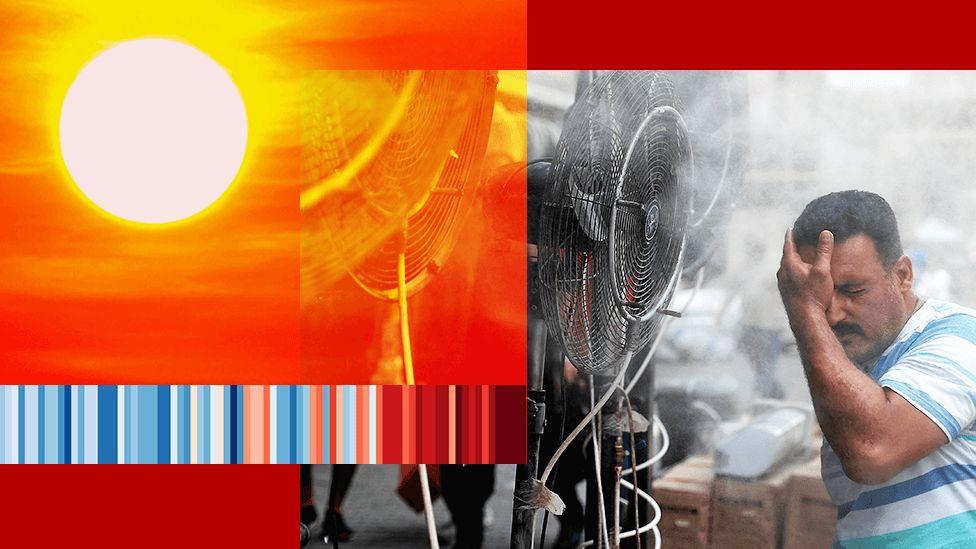Africa-Press – Eritrea. The number of extremely hot days every year when the temperature reaches 50C has doubled since the 1980s, a global BBC analysis has found.
They also now happen in more areas of the world than before, presenting unprecedented challenges to human health and to how we live.
The total number of days above 50C (122F) has increased in each decade since 1980. On average, between 1980 and 2009, temperatures passed 50C about 14 days a year.
The number rose to 26 days a year between 2010 and 2019.
In the same period, temperatures of 45C and above occurred on average an extra two weeks a year.
“The increase can be 100% attributed to the burning of fossil fuels,” says Dr Friederike Otto, associate director of the Environmental Change Institute at the University of Oxford.
More places are now reaching 50C
A location refers to an individual area of the globe about 25 sq km.
Climate data is typically presented in gridded squares that make up a large area.
The grids in this dataset are 0.25 degrees latitude by 0.25 degrees longitude.
Locations displayed on the map above are those where the maximum temperature in a grid area went above 50C on a given day that year.
The size of the circle plotted on the map relates to the number of days per year that crossed 50C at that specific location.
The circles range in size from 1 to 25 days.
When all years are represented, the circles show the total number of days over 50C at each point. The scale remains capped at 25 days for legibility.
This analysis uses maximum daily temperatures from the global ERA5 dataset, produced by the Copernicus Climate Change Service.
Climate data is typically presented in gridded squares that make up a large area. Although each grid can contain different topographies, the data treats each grid area uniformly.
ERA5 combines weather observations from many sources, such as stations and satellites, with data from weather forecasting models.
This process fills in gaps created by poor station coverage in many parts of the world.
As the whole world warms, extreme temperatures become more likely.
High heat can be deadly for humans and nature, and cause major problems to buildings, roads and power systems.
Temperatures of 50C happen predominantly in the Middle East and Gulf regions.
And after record-breaking temperatures of 48.8C in Italy and 49.6C in Canada this summer, scientists have warned that days over 50C will happen elsewhere unless we cut fossil fuel emissions.
“We need to act quickly. The faster we cut our emissions, the better off we’ll all be,” says Dr Sihan Li, a climate researcher at the School of Geography and the Environment at the University of Oxford.
“With continued emissions and lack of action, not only will these extreme heat events become more severe and more frequent, but emergency response and recovery will become more challenging,” warns Dr Li.
The BBC analysis also found that in the most recent decade, maximum temperatures increased by 0.5C compared with the long-term average from 1980 to 2009.
But these increases have not been felt equally around the world: Eastern Europe, southern Africa and Brazil saw some maximum temperatures rise by more than 1C, and parts of the Arctic and Middle East recorded increases of more than 2C.
Scientists are calling for urgent action from world leaders at a UN summit in Glasgow in November, where governments will be asked to commit to new emissions cuts in order to limit global temperature rises.
Impacts of extreme heat
This BBC analysis launches a documentary series called Life at 50C investigating how extreme heat is affecting lives across the world.
Even below 50C, high temperatures and humidity can create severe health risks.
As many as 1.2 billion people around the world could face heat stress conditions by 2100 if current levels of global warming continue, according to a study from Rutgers University in the US published last year. That is at least four times more than those affected today.
People are also facing difficult choices as the landscape around them changes, as extreme heat makes drought and wildfires more likely. While, other factors can contribute, climate change is also an important driving force behind desertification.
Sheikh Kazem Al Kaabi is a wheat farmer from a village in central Iraq. The land around him was once fertile enough to sustain him and his neighbours, but it has gradually become dry and barren.
“All this land was green, but all of that is gone. Now it is a desert, drought.”
Almost all the people from his village have moved away to look for work in other provinces.
“I lost my brother, dear friends and loyal neighbours. They shared everything with me, even my laughter. Now nobody shares anything with me, I’m just face-to-face with this empty land.”







